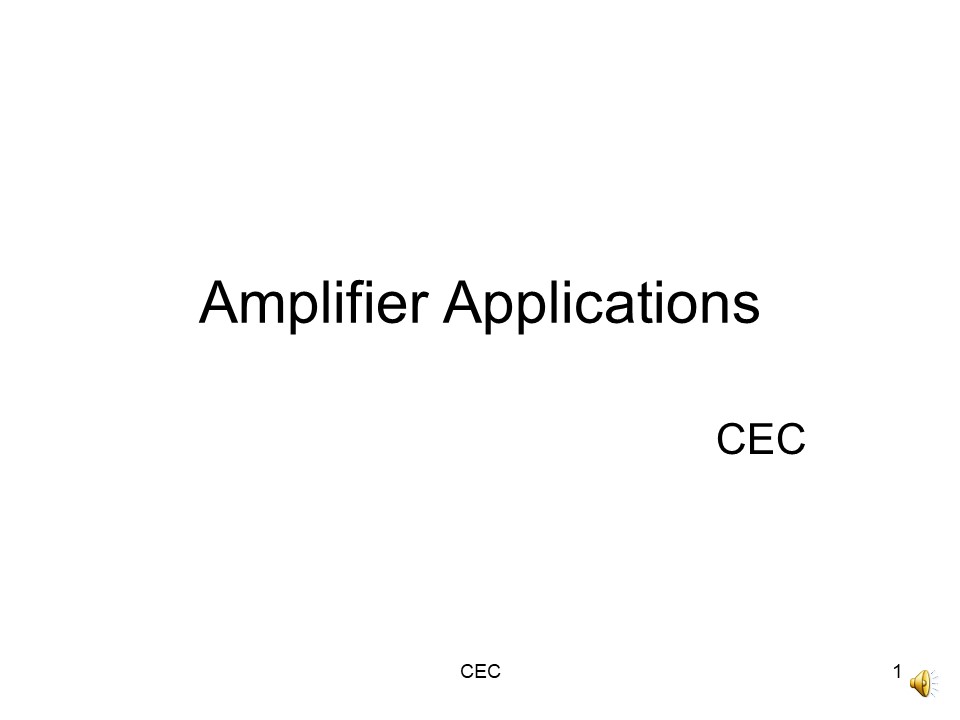Amplifier Applications - PowerPoint PPT Presentation
Title:
Amplifier Applications
Description:
The attached narrated power point presentation attempts to explain some of the applications of amplifiers. – PowerPoint PPT presentation
Number of Views:16
Title: Amplifier Applications
1
Amplifier Applications
- CEC
2
Contents
- Block Level Treatment of a
- Public Address System.
- Public Address System with Equaliser.
- Instrumentation System.
3
Public Address System
4
Contents
- Introduction and Block Schematics.
- Public Address System.
- Public Address System with Equaliser.
- Applications.
5
Public Address System
- An electronic system comprising of microphones,
amplifiers loudspeakers, and related equipment. - Increases the apparent volume (loudness) of a
human voice, musical instrument, or other
acoustic sound source or recorded sound or music.
6
Public Address System
Sound Signals
Sound
Sound is reproduced faithfully when loud speaker
reproduces the sound signals from the microphone
sufficiently loud without noise.
7
Public Address System
- Sound source at the input side of public address
system. - Microphone converts speech/sound energy to
electrical energy. - Output from microphone will be of very low
amplitudes (of the order of µV). - Microphone output to be amplified in terms of
voltage and power.
8
Public Address System
- Mixer multiplexes/combines several channels, ie
outputs of several microphones. - Mixer needed if instruments and vocal are to be
combined. - Preamplifier increases input amplitude for
further processing.
9
Public Address System
- Power amplifier boosts current, makes signal
strong enough to drive the loudspeaker. - Loudspeaker converts electrical energy back to
sound energy. - Loudspeaker to reproduce sound faithfully.
10
PA System with Equaliser
11
Equalization
- Process of altering the frequency response of a
PA System using filters. - Adjusts the magnitude of audio signals at
selected frequencies. - Used to eliminate undesired sounds.
- To make some voices more prominent.
12
Equalization
- Graphic equalizer permits the operator to see
graphically and control different frequency
bands. - Graphic equalizer separates low frequency (bass)
and high frequency (treble) signals. - Bass and Treble amplified and reproduced using
separate loud speakers.
13
PA Applications
- Live Music Concerts.
- Public Speech Scenarios.
- Replay of pre-recorded music/speech.
- Announcement System at a school, office or
outdoor gathering/function. - Announcement Systems in Public Places,
Auditoriums and Stadiums. - Public Warning/Announcement.
14
Instrumentation System
15
Contents
- Definition and Block Diagram.
- Sensing/Transduction.
- Types of Transducers.
- Signal Conditioning.
- Transmission and Presentation.
- Advanced Instrumentation.
- Applications.
16
Instrumentation
- Branch of engineering/technology dealing with
instruments. - Deals with instruments to record, monitor,
indicate and control various physical parameters
such as pressure, temperature etc.
17
Basic Block Diagram
Conversion to Electrical Quantity
Amplification/Processing
Physical Quantity
18
Generalised Block Diagram of an Instrumentation
System
19
Primary Sensing Element
- Also known as sensor.
- Transducers used as primary sensing elements.
- Physical quantity (temperature, pressure etc.)
sensed, converted into analog signal. - Output of transducer an electrical signal i.e.
voltage, current etc.
20
Sensor vs Transducer
- Transducer to convert a non-electrical signal
into an electrical signal. - Sensor to measure physical changes in the
surroundings like temperature, light, etc, for
conversion to a readable signal. - Sensors barometer, accelerometer.
- Transducers thermocouple, microphones.
- Transducer consists of a sensor and signals
conditioning circuits.
21
Transducer Classifications
- Primary transducer, detector or sensor senses a
physical parameter (pressure, humidity,
temperature etc.), converts it into readable
physical parameter. - Secondary transducer converts the output of
primary transducer into electrical signal. - Eg Bourdons Tube converts pressure into a
displacement, LVDT converts it into a voltage.
22
Transducer Classifications
- Active transducer self generating, no external
power supply to produce output. Eg Thermocouple,
Photovoltaic Cell. - Passive transducer - externally powered,
auxiliary power supply to produce output. Eg
Capacitive, Resistive and Inductive transducers. - Analog transducer - converts input signal into
analog output. Eg Strain Gauge, LVDT. - Digital transducer - converts input signal into
electrical pulses.
23
Transducer Classifications
- Electrical transducers - sense physical
parameter, converts it into electrical signal. - Mechanical transducers - convert one form of
physical quantity into another form of physical
quantity. - Optical transducers - convert light into
electrical quantity, also called photoelectric
transducers.
24
Inverse Transducer
- Converts the electric quantity into a physical
quantity. - High electrical input and low non-electrical
output. - Eg Piezoelectric Crystal - voltage across the
surface of a piezoelectric crystal changes its
dimension.
25
Variable Conversion Element
- Converts the output of primary sensing element
into a suitable form without changing
information. - Secondary transducers may perform the conversion.
26
Variable Manipulation Element
- Manipulation - change in numerical value of
signal. - To convert the signal into suitable range.
27
Data Transmission Element
- For measurement and control from a distance.
- Data transmitted from one place to another place
through a channel. - Transmission path are pneumatic pipe, electrical
cable and radio links. - Telemetry system uses radio link.
28
Data Presentation or Controlling Element
- Output is recorded or given to the controller to
perform action. - Performs different functions like indicating,
recording or controlling. - Can be a display panel/panel meter.
29
Digital Instrumentation System
30
Smart Instrumentation and Telemetry
Computer controlled Smart Instrumentation uses
smart sensors and smart instruments which can be
interfaced to the computer or microcontroller
through serial/parallel ports.
31
Applications
- In Process Control Industries (Chemical and
Fertilizer Plants) to measure and control
parameters such as pressure, temperature etc. - In test stands during testing stages of
propulsion systems and rockets to measure and
control various parameters from a distance. - In Thermal and Nuclear Power Plants.
32
References
- Your prescribed text books.
- K A Nawas and T A Suhail, Basics of Electronics
Engineering, Rajath Publishers, 2nd Edition,
2016. - https//www.polytechnichub.com
- https//circuitglobe.com/types-of-transducer.html
- https//www.stechies.com/difference-between-sensor
-transducer/ - Other Internet Resources.
33
- Thank You..































